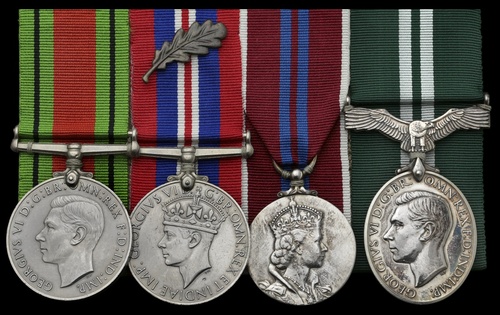
Auction: 22003 - Orders, Decorations and Medals
Lot: 336
A scarce Second World War campaign group of four awarded to Group Officer C. M. Ambrose, Women's Royal Air Force, late Women's Auxiliary Air Force
Having been mentioned in despatches for gallant deeds during an air raid on her aerodrome in the summer of 1941, she was attached to the offices of the Assistant Chief of Air Staff (Intelligence), in which capacity she debriefed escapers and evaders and liaised with M.I. 5 and M.I. 6
Post-war, she commanded the Women's Royal Air Force contingent at the Coronation parade in 1953
Defence and War Medals 1939-45, with M.I.D. oak leaf; Coronation 1953; Air Efficiency Award, G.VI.R., 1st issue (Sqn. Off. C. M. Ambrose. W.A.A.F.), light contact marks, nearly extremely fine (4)
Cecil Marguerite Ambrose was born at Horsley, Derbyshire, on 29 October 1905, the daughter of a clergyman.
A secretary by profession, she joined the 20th London (R.A.F.) Company, Auxiliary Territorial Service at the time of the Munich Crisis and was commissioned in the Women's Auxiliary Air Force in October 1939.
The Blitz
Posted to R.A.F. Kidbrooke in south-east London, she was likewise employed 'when the first big raid on the East End and docks happened. It was very frightening' (Her accompanying typed career summary, refers).
In early 1941, she was appointed a Section Officer at R.A.F. Abingdon in Oxfordshire, commanded by Group Captain Herbert Massey, D.S.O., D.F.C., a colourful veteran of the Great War, who ended up as the Senior British Officer at Stulag Luft III at the time of the 'Great Escape'.
Meanwhile, Ambrose's earlier experiences of the London Blitz held her in good stead, for Abingdon was bombed on at least three occasions in 1941. No-one was killed, but some were wounded, and the Officers' Mess was among the damaged buildings. Here, then, what is believed to be the background to her mention in despatches (London Gazette 24 September 1941, refers).
Escape and Evasion work
Advanced to the temporary rank of Flight Officer, she next served as Adjutant of the W.A.A.F.'s Officers' School - which she 'hated'. At length, however, she wrangled an appointment with the Assistant Chief of Air Staff (Intelligence) (ACASI), in which role she served for the remainder of the war. And a fascinating role it proved. ACASI was based in the Horseferry Road in London, with underground offices connected to the War Cabinet and other offices in Whitehall.
Ambrose was given charge of a section under the Director of Security, replacing a Squadron Leader who had been returned to operations:
'My job was very interesting, including receiving escapers and evaders, and getting them back officially on the books, which required a certain amount of liaison with M.I. 5 and M.I. 6 (War Office), and with the U.S.A.F. at Bushey Park. I worked long hours and we had one day off a fortnight in the run up to D-Day, but it was worth it and I enjoyed it' (ibid).
Coronation 1953: on parade
Granted a permanent commission in the Women's Royal Air Force following the cessation of hostilities, Ambrose was awarded the Air Efficiency Award in Air Ministry Order 289 of 1947.
Having then been advanced to Wing Officer in July 1950, she was given charge of the W.R.A.F. contingent at the Coronation Parade in 1953. She finally retired in the rank of Group Officer in July 1958 and died on the Isle of Wight in October 1994, aged 89 years; sold with her typed statement of services.
Subject to 20% VAT on Buyer’s Premium. For more information please view Terms and Conditions for Buyers.
Sold for
£400
Starting price
£270




